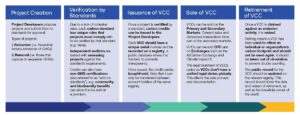What is Carbon Credit Certification?
Carbon Credit Certification
A carbon credit is a tradable certificate that represents one tonne of CO2 reduced or removed from the atmosphere. They are produced from certified projects, such as reforestation or renewable energy, or by capturing and storing carbon in the ground. The credits are then sold in the voluntary carbon market (VCM), and are used to offset unavoidable emissions for businesses and individuals. Projects must follow rigorous protocols to be certified by legitimate third-party verification bodies such as Gold Standard, Verra or Climate Action Reserve.
While governments regulate their own carbon pricing programs, the VCM is free-market based. The community of buyers and sellers includes companies, investors, banks and environmental organizations. This marketplace is set up with the aim to deliver carbon reductions, biodiversity and development benefits in a cost-effective way. Certification helps to ensure the quality of carbon credits and offsets traded on the platform.

For a carbon.credit to be valid, it must reduce or remove at least one tonne of GHG emissions over a three-year period. Project developers must also have a plan in place to monitor the impact of their work and ensure that the emission reductions continue as planned over time. This process is called Monitoring, Reporting and Verification (MRV). The carbon market community has set up a number of voluntary standards that are designed to guide the development of projects. These include the Verified Carbon Standard, Carbon Capture and Storage Standard, Gold Standard, Climate Action Reserve and the American Carbon Registry among others.
What is Carbon Credit Certification?
As the carbon offset market continues to expand, ensuring that offsets are genuine is becoming even more important. Without this assurance, anyone can claim they are offsetting their emissions, but the impact is often not verified. That’s why it is so important to look for the seal of approval from a reputable carbon credit certification company, like Riverse.
Once you’ve chosen your carbon offset provider, they will help you to determine your footprint and purchase the number of carbon credits needed to reach your emissions goal. This will typically involve a survey of your business and your activity, followed by an assessment of the emissions-reducing activities you have in place.
After a year, your project developer will verify that the project is doing what it’s supposed to do. This could be as simple as making sure the trees are still alive and growing, or that the renewable energy plant is still capturing carbon from the air. The developer will then submit annual and monitoring reports to the independent validation and verification body, who will audit the project to ensure that it’s been executed according to the plan.
Finally, the independent validation and verification body will issue a certificate to the project developer. This is your proof that you are offsetting your emissions by purchasing carbon credits from a real, genuine and permanent climate mitigation project.